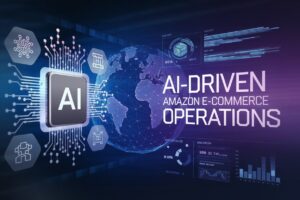In today’s digital age, data has become a crucial basis for business decision-making. For e-commerce platforms, especially large ones like Amazon, data scraping is particularly important. However, several factors must be considered when conducting Amazon e-commerce data scraping to ensure legality, technical feasibility, cost-effectiveness, efficiency, and timeliness. This article will delve into the considerations for Amazon e-commerce data scraping from the perspectives of legality, technology, cost, efficiency, and timeliness.
Legal Considerations
1. Complying with Data Protection Laws
During data scraping, it is essential to comply with relevant laws and regulations. For example, the General Data Protection Regulation (GDPR) imposes strict requirements on handling data of EU citizens. If the target data involves EU user information, the scraping process and storage methods must comply with GDPR requirements, or face hefty fines.
2. Avoiding Violation of Service Terms
Amazon’s terms of service explicitly prohibit unauthorized automated data scraping (i.e., crawling). Violating these terms can result in being banned from accessing the Amazon platform or even facing legal action. Therefore, it is crucial to thoroughly read and adhere to Amazon’s terms of service before engaging in data scraping.
3. Avoiding Intellectual Property Infringement
The scraped data may include copyrighted content such as product descriptions and images. Using these contents without authorization could constitute intellectual property infringement. Therefore, it is important to ensure that the use of data does not infringe on Amazon’s or third-party sellers’ intellectual property rights.
Technical Considerations
1. Defining Scraping Needs and Goals
Before conducting data scraping, it is important to clearly define the specific needs and goals. For instance, identify what categories of data (product information, prices, reviews, etc.) are needed and how this data will be used. Clear requirements help design an efficient scraping strategy.
2. Choosing Appropriate Tools and Technologies
Data scraping can be implemented through various technical means, such as web crawlers and API calls. Choosing the right tools and technologies is key to successfully scraping data. For example, using Python libraries like BeautifulSoup and Scrapy can effectively crawl web data, while utilizing Amazon’s provided APIs can obtain data more stably.
3. Ensuring Data Quality and Integrity
During data scraping, it is crucial to ensure the quality and integrity of the data. For instance, multiple data entries for the same product might be redundant or conflicting, requiring data cleaning and deduplication. Additionally, handling missing and abnormal values ensures data accuracy.
Cost Considerations
1. Calculating Hardware and Software Costs
Data scraping involves hardware and software costs, including servers, storage devices, scraping tools, and API call fees. When selecting tools, consider their cost-effectiveness and opt for solutions that meet requirements at a lower cost.
2. Evaluating Labor Costs
Data scraping requires a professional technical team to design and maintain the scraping system. If lacking the necessary technical talent internally, consider outsourcing to specialized data scraping companies or using third-party data scraping services. Additionally, account for the labor cost of data processing and analysis.
3. Estimating Hidden Costs
Unexpected costs might arise during data scraping, such as IP blocking, CAPTCHA interceptions, and changes in data formats. These issues can increase development and maintenance costs, so it is advisable to reserve some contingency funds in the budget.
Efficiency Considerations
1. Optimizing Scraping Speed
The efficiency of data scraping directly impacts the timeliness and effectiveness of the data. Techniques such as distributed crawlers and multithreading can enhance scraping speed. Additionally, set a reasonable request frequency for crawlers to avoid being banned by the target website.
2. Handling Large-Scale Data
For large e-commerce platforms like Amazon, the volume of data can exceed single-machine processing capabilities. Utilizing big data processing technologies like Hadoop and Spark for distributed data storage and processing can improve the efficiency of data scraping and handling.
3. Monitoring and Maintenance
Real-time monitoring of the scraping system during data scraping is necessary to promptly detect and address anomalies. Additionally, regularly maintain and optimize the system to ensure the stability and efficiency of data scraping.
Timeliness Considerations
1. Real-Time Data Scraping
For applications requiring real-time data support, such as price monitoring and inventory management, the timeliness of data scraping is crucial. Real-time crawlers or API calls can be used to achieve data updates, ensuring the data is up-to-date.
2. Data Update Frequency
Different types of data require different update frequencies. For example, product prices might change daily, while product reviews change more slowly. Setting a reasonable data update frequency based on actual needs can enhance the efficiency and effectiveness of data scraping.
3. Data Storage and Access
After data scraping, data needs to be stored and managed. Using relational databases, NoSQL databases, or big data storage technologies like MySQL, MongoDB, and HDFS can ensure efficient data storage and quick access. Additionally, regularly back up data to prevent data loss.
Case Studies
Case 1: Price Monitoring for an E-commerce Company
An e-commerce company needs to monitor competitors’ product prices in real-time to adjust its pricing strategy. The company uses a distributed crawler system to periodically scrape relevant product price data on Amazon and uses big data analysis technology for real-time price comparison and trend prediction. By optimizing the crawling strategy and technical means, the company achieves efficient and stable data scraping, significantly enhancing its market competitiveness.
Case 2: Review Analysis for a Market Research Company
A market research company needs to analyze product reviews on Amazon to understand consumers’ true feedback and needs. The company employs web crawler technology to periodically scrape relevant product reviews and uses natural language processing technology to perform sentiment analysis and topic mining. Through data analysis, the company provides precise market research reports to its clients, helping them improve products and services.
Simplifying Data Scraping with Pangolin Scrape API
For users without data scraping capabilities or those unwilling to build a scraping team, third-party data scraping services such as Pangolin Scrape API can be considered. Pangolin Scrape API is an efficient and user-friendly data scraping tool with the following advantages and features:
1. Postal Code Specific Scraping
Pangolin Scrape API supports data scraping by specified postal codes, allowing for flexible setting of scraping ranges according to actual needs, enhancing the relevance and practicality of the data.
2. SP Advertisement Scraping
For advertisement data on e-commerce platforms, Pangolin Scrape API offers dedicated scraping features, making it easy for users to obtain SP advertisement data for ad effect analysis and optimization.
3. Easy Integration with Existing Data Systems
Pangolin Scrape API supports various data formats and interface protocols, allowing easy integration with users’ existing data systems for seamless data connection and efficient utilization.
4. Efficient and Stable Data Scraping
Pangolin Scrape API employs advanced technical means to ensure the efficiency and stability of data scraping. It also provides detailed documentation and technical support to help users quickly get started and solve various issues in data scraping.
By using Pangolin Scrape API, users can easily achieve efficient Amazon e-commerce data scraping, avoid technical challenges and legal risks, and focus more on data analysis and business decision-making.
Conclusion
Amazon e-commerce data scraping is a complex task involving multiple considerations. From legal compliance to technical implementation, from cost control to efficiency optimization, every aspect needs careful consideration and proper planning. Through reasonable strategies and technical means, efficient, legal, and low-cost data scraping can be achieved, providing strong data support for e-commerce business decisions. Moreover, leveraging third-party data scraping tools like Pangolin Scrape API can further simplify the data scraping process, enhance data utilization efficiency, and bring more value to enterprises.






